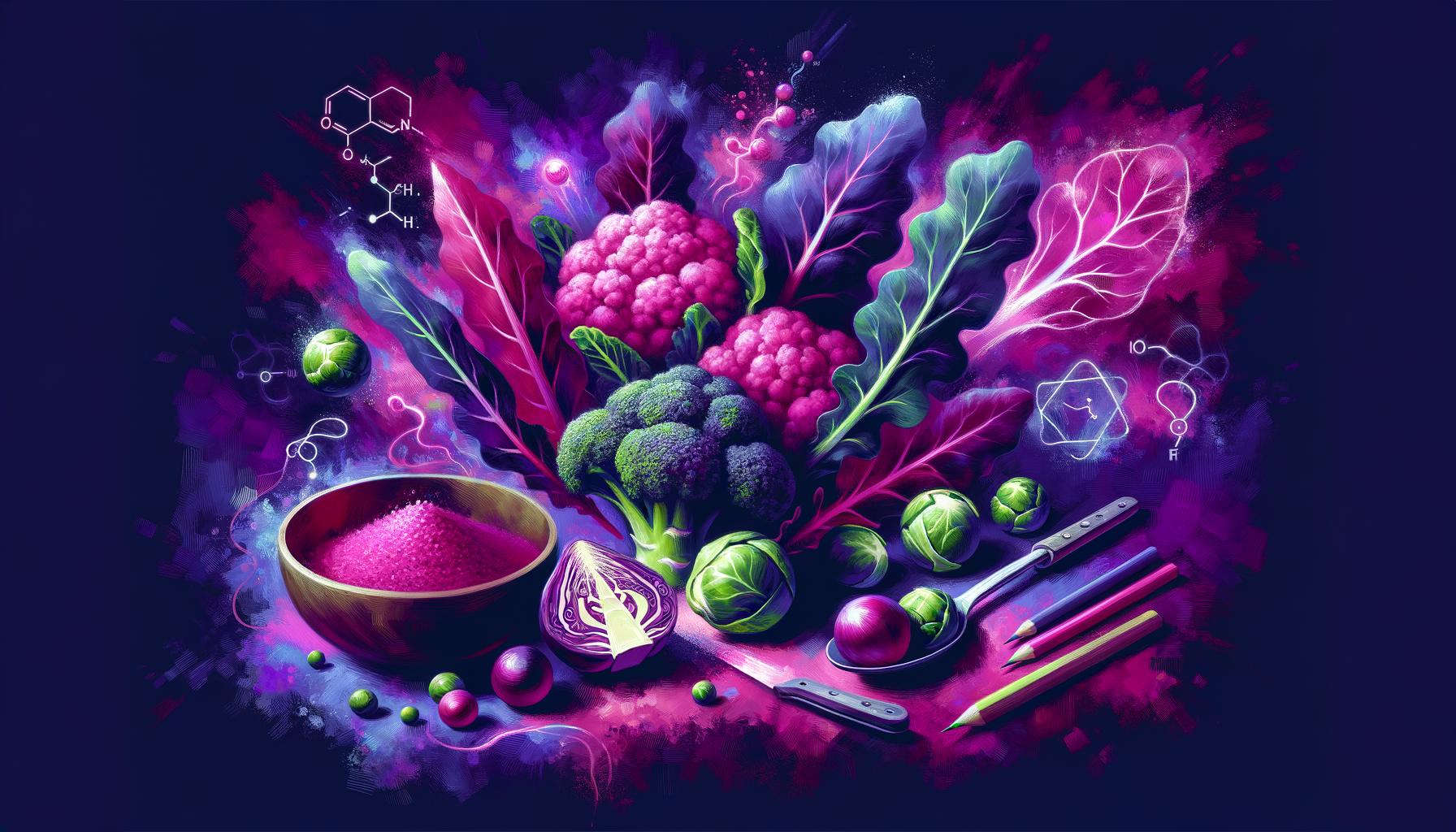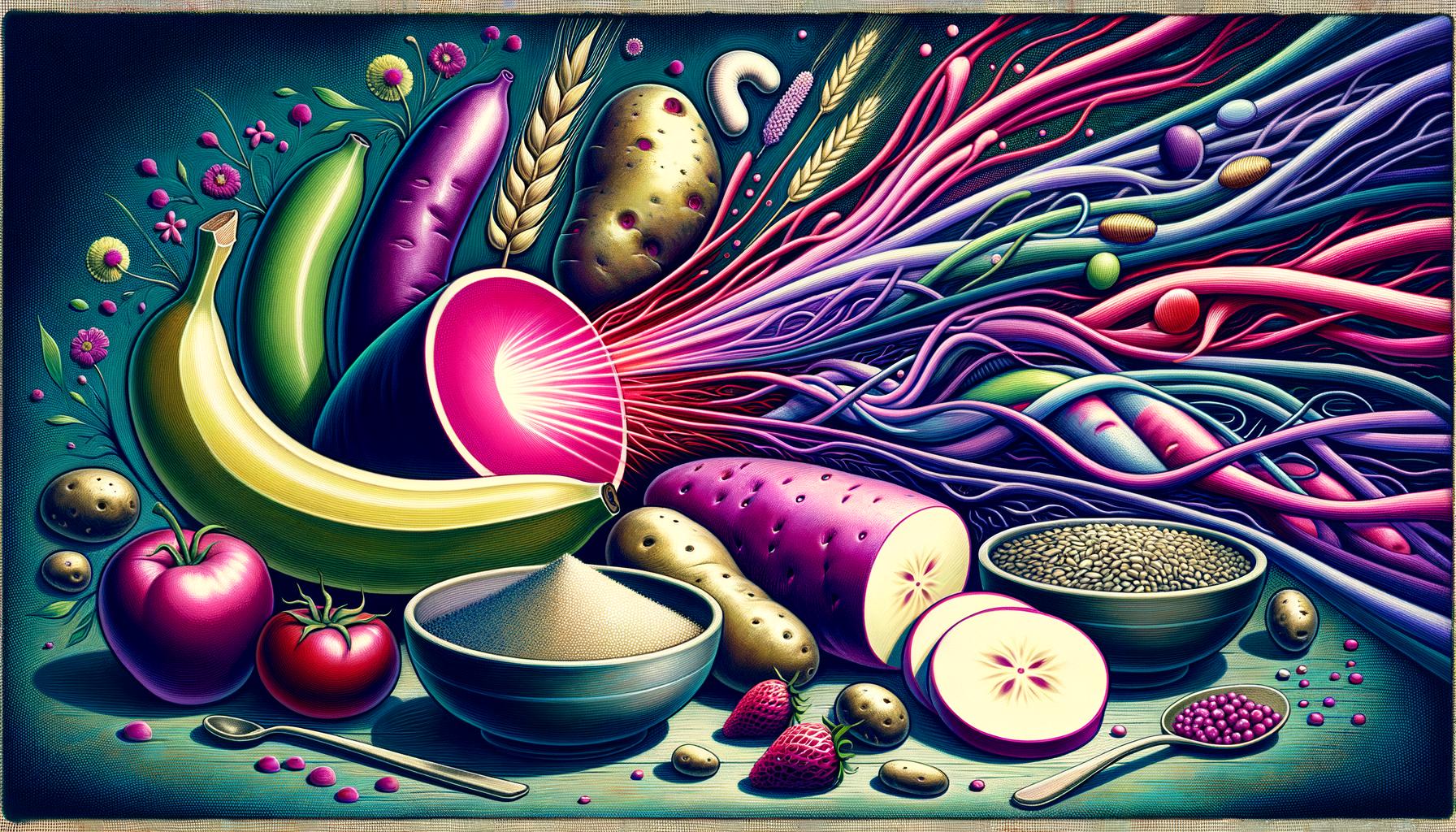· nutrition · 16 min read
Unlocking Sulforaphane's Anti-Cancer Potential
Explore the powerful anti-cancer benefits of sulforaphane, a compound found in cruciferous vegetables, and learn how incorporating these foods into your diet can aid in cancer prevention.

In This Post
The Fact Why Should I Care How To Put In Action Start Tomorrow Guide How does it effect my ability to focus How does it impact my daily life How does it help me make friends How does it help me manage stress How does it effect my mood Summary: Remember Refresher Checklist The Full Research Article CitationsPrint Out The Tomorrow Checklist!
Sign up for our newsletter and receive a copy today, so that, you can start tomorrow! Or the next day, or the day after that. I forget everything and starting things is hard at least for me so these checklists are godsend.
Print Out The Remember Refresher Checklist!
Sign up for our newsletter and download your own copy of the Remember Refresher Checklist, so that, you can easily put it on your fridge and help you stay on target towards your WHY. Every little bit helps.
Introduction
Sulforaphane, a natural plant compound found in cruciferous vegetables, has garnered attention for its potential in fighting cancer. This potent phytochemical emerges through the enzymatic production of sulforaphane when the vegetables containing it are chopped, chewed, or otherwise damaged, making it a fascinating subject for both scientists and those interested in the nutritional prevention of cancer. Cruciferous vegetables, such as broccoli, kale, and Brussels sprouts, are vital components of a diet aimed at cancer prevention due to their high content of sulforaphane and other health-promoting phytochemicals.
Overview of Sulforaphane
Sulforaphane is a compound that showcases significant anti-cancer properties, especially known for its ability to neutralize carcinogens, reduce inflammation, and inhibit tumor growth. It is among the most potent anti-cancer compounds in vegetables, highlighting the crucial role of diet in cancer prevention. The benefits of sulforaphane extend beyond its anti-cancer effects, encompassing detoxifying properties that benefit overall health. Its bioavailability and absorption can be influenced by how cruciferous vegetables are prepared and consumed, making it a compelling topic for those looking to enhance their health through diet.
Importance of Cruciferous Vegetables
Cruciferous vegetables play a pivotal role in cancer prevention, primarily through their sulforaphane content. Here’s a quick checklist to help you incorporate these vital vegetables into your diet:
- Eat a variety of cruciferous vegetables, such as broccoli, kale, and Brussels sprouts, to get the full range of health benefits they offer.
- Aim to include these vegetables in your meals at least 3-4 times a week for optimal sulforaphane intake.
- Experiment with different cooking methods, such as steaming or stir-frying, to find tasty ways to prepare them while preserving their beneficial compounds.
Incorporating cruciferous vegetables into your diet can be a straightforward and effective strategy for reducing cancer risk and enhancing overall health. With their plentiful sulforaphane content and wide-ranging health benefits, these vegetables are indispensable allies in the fight against cancer.
The Science of Sulforaphane
Biochemical Production of Sulforaphane in Vegetables
Sulforaphane is a remarkable compound found abundantly in cruciferous vegetables like broccoli, Brussels sprouts, and kale. But have you ever wondered how these vegetables produce sulforaphane? The process is fascinating and hinges on a biochemical reaction that involves two key components: glucoraphanin and the enzyme myrosinase.
When a cruciferous vegetable is in its natural, undisturbed state, glucoraphanin (a glucosinolate) and myrosinase (an enzyme) are stored in separate compartments within the cell. This separation is crucial because when they come into contact, they react to produce sulforaphane, a compound known for its anti-cancer properties among other health benefits.
The production of sulforaphane is not just a random occurrence; it’s a plant’s defense mechanism. When the vegetable is chopped, chewed, or otherwise damaged, it triggers the release of these components, leading them to mix and kickstart the reaction that results in the creation of sulforaphane. This process is a perfect example of the enzymatic production of sulforaphane, showcasing nature’s ingenuity in developing mechanisms for protection that, coincidentally, provide substantial health benefits to humans.
How Chewing Triggers Sulforaphane Release
The act of chewing does more than just break down food to make it easier to digest; when it comes to cruciferous vegetables, it initiates the release of sulforaphane, turning each bite into a step towards leveraging the cancer-preventing properties of these vegetables.
Checklist: How to Enhance Sulforaphane Release Through Chewing
- Chew thoroughly: The mechanical action of chewing disrupts the cells of the vegetable, allowing glucoraphanin and myrosinase to come into contact and react.
- Eat cruciferous vegetables raw or lightly cooked: Cooking can denature the myrosinase enzyme, reducing its ability to convert glucoraphanin to sulforaphane. Eating these veggies raw, or lightly steaming them, can retain the enzyme’s activity.
- Pair with myrosinase-rich foods: If you do cook your cruciferous vegetables, consider pairing them with foods high in myrosinase, like mustard powder or raw cruciferous vegetables, to boost sulforaphane production.
- Allow chopped vegetables to sit: After chopping cruciferous vegetables, let them sit for a few minutes before cooking. This resting period can increase sulforaphane production by allowing the enzymatic reaction to occur.
Understanding how the process works and optimizing it through how we prepare and consume our food can significantly impact the bioavailability of sulforaphane, enhancing its health benefits. The production and release of sulforaphane are splendid examples of the intricate ways our diet interacts with our body’s biological functions to support health, emphasizing the importance of dietary sources of sulforaphane in cancer prevention and overall well-being.
In summary, the science behind the production and release of sulforaphane in cruciferous vegetables highlights the incredible ways our food can support our health, particularly in cancer prevention. By understanding and applying simple strategies, we can optimize our intake of this powerful phytochemical, making each bite of cruciferous vegetables a step toward improved health outcomes.
Anti-Cancer Effects of Sulforaphane
Sulforaphane, a powerful compound found in cruciferous vegetables like broccoli, Brussels sprouts, and kale, has gained attention for its potential anti-cancer properties. This section delves into how sulforaphane works to neutralize carcinogens, reduce inflammation, and inhibit tumor growth, playing a significant role in cancer prevention.
Neutralizing Carcinogens
One of the critical ways sulforaphane fights against cancer is by neutralizing carcinogens, the harmful chemicals that can lead to cancer formation. Sulforaphane does so through a process called phase II enzyme induction. This process essentially boosts the body’s ability to detoxify and expel carcinogens before they can damage DNA and initiate cancer. The enzymes that sulforaphane activates help to convert carcinogens into less harmful compounds that the body can easily eliminate.
Inflammation Reduction and Its Impact on Cancer
- Chronic inflammation is closely linked to an increased risk of cancer. Sulforaphane exerts anti-inflammatory effects that mitigate this risk and contribute to its anti-cancer potential.
- Sulforaphane works by inhibiting the activation of NF-kB, a protein that plays a significant role in regulating the immune response to inflammation. By blocking NF-kB, sulforaphane can reduce the production of inflammatory molecules, which are often elevated in chronic diseases, including cancer.
Sulforaphane’s Role in Inhibiting Tumor Growth
Sulforaphane’s impact on tumor growth is multifaceted and profound. It attacks tumor growth through various mechanisms:
- Apoptosis Induction: Sulforaphane can induce apoptosis or programmed cell death in cancer cells, a critical capability for controlling cancer growth.
- Cell Cycle Arrest: It has the power to stop the cell cycle in cancer cells, preventing them from dividing and growing.
- Anti-Angiogenesis: Sulforaphane inhibits the formation of new blood vessels (angiogenesis) that tumors need to grow.
- Inhibition of Metastasis: It reduces the ability of cancer cells to spread to other parts of the body.
How Sulforaphane Attacks Cancer at its Roots
- Prevention of DNA Damage: By neutralizing carcinogens, sulforaphane protects DNA from damage that could lead to cancer.
- Reduction of Inflammation: Given the link between inflammation and cancer, sulforaphane’s anti-inflammatory effects help guard against cancer development.
- Halting Tumor Growth: Through apoptosis induction, cell cycle arrest, anti-angiogenesis, and metastasis inhibition, sulforaphane directly combats tumor growth.
Checklist: Maximizing Sulforaphane’s Anti-Cancer Effects
- Consume a variety of cruciferous vegetables daily to ensure a steady intake of sulforaphane.
- Consider lightly steaming rather than boiling or microwaving these vegetables to preserve sulforaphane content.
- Incorporate ingredients high in myrosinase, such as mustard powder, in dishes containing cruciferous vegetables to enhance sulforaphane absorption.
The research on sulforaphane continues to uncover its vast potential in cancer prevention. By neutralizing carcinogens, reducing inflammation, and directly inhibiting tumor growth, sulforaphane offers a multifaceted approach to combat cancer. Including cruciferous vegetables in your diet is a practical way to tap into these benefits, contributing to a comprehensive strategy for cancer prevention.
Incorporating Sulforaphane into Your Diet
Optimal Ways to Consume Cruciferous Vegetables
Unlocking the full potential of sulforaphane begins with understanding the best ways to consume cruciferous vegetables. These power-packed plants, including broccoli, Brussels sprouts, kale, and cabbage, carry significant health benefits, particularly in cancer prevention. However, to maximize the sulforaphane intake from these vegetables, certain methods are more effective than others.
Raw consumption is arguably one of the best ways to ensure you’re getting the most sulforaphane. The enzymatic production of sulforaphane, triggered by the myrosinase enzyme, occurs most efficiently when these vegetables are chewed raw. This process can be somewhat diminished during cooking, especially if the vegetables are overcooked. However, if raw vegetables are not to your taste, steaming them lightly is the next best option. This method preserves most of the myrosinase enzyme activity, ensuring that sulforaphane is still produced.
It is also worth noting the importance of consuming whole food sources rather than relying solely on supplements. Dietary sources of sulforaphane from cruciferous vegetables not only provide this valuable compound but also a wide range of other nutrients and phytochemicals beneficial for health. By focusing on a variety of these vegetables, you can take a holistic approach to harness their anti-cancer compounds and overall nutritional benefits.
Recipes Rich in Sulforaphane
To incorporate the maximum amount of sulforaphane into your diet, consider these simple yet nutritious recipes:
Broccoli and Kale Salad: Combine raw broccoli florets and chopped kale with a dressing of lemon juice, olive oil, and garlic. Top with sliced almonds for a crunchy finish.
Brussels Sprouts with Mustard Sauce: Lightly steam Brussels sprouts until tender. Mix with a sauce made from Dijon mustard, apple cider vinegar, and a touch of honey for a delicious side dish.
Spicy Cabbage Stir-Fry: Quickly stir-fry chopped cabbage with garlic, onions, and chili flakes in a bit of oil. This method preserves the cabbage’s nutrients while adding a kick of flavor.
Tips for Maximizing Sulforaphane Intake
To further enhance your sulforaphane intake, consider the following tips:
Chew Thoroughly: Chewing cruciferous vegetables thoroughly can help activate more myrosinase enzyme, thereby increasing sulforaphane production.
Pair with Myrosinase-Rich Foods: Consuming foods high in myrosinase, such as mustard powder, alongside cruciferous vegetables can enhance sulforaphane absorption.
Avoid Overcooking: Overcooking can destroy the myrosinase enzyme, significantly reducing sulforaphane levels. Opt for light steaming or enjoy the vegetables raw.
Store Vegetables Properly: To preserve nutrient content, store cruciferous vegetables in a cool, dry place and consume them while fresh.
Checklist for Sulforaphane Optimization:
- Include a variety of cruciferous vegetables in your diet.
- Consume vegetables raw or lightly steamed for maximum benefits.
- Pair cruciferous vegetables with myrosinase-rich foods for enhanced absorption.
- Chew thoroughly to activate sulforaphane production.
- Avoid overcooking vegetables to preserve myrosinase enzyme activity.
Incorporating sulforaphane into your diet through the consumption of cruciferous vegetables is a natural and effective way to harness its anti-cancer potential. By following the tips and incorporating the suggested recipes into your diet, you can significantly boost your sulforaphane intake, contributing to your overall health and cancer prevention efforts.
FAQs
How Does Sulforaphane Neutralize Carcinogens?
Sulforaphane, a potent compound found in cruciferous vegetables like broccoli, Brussels sprouts, and kale, is celebrated for its cancer-fighting abilities. The process through which sulforaphane neutralizes carcinogens is deeply rooted in its detoxifying properties. When ingested, sulforaphane activates certain enzymes in the body known as phase II detoxification enzymes. These enzymes play a critical role in rendering harmful compounds, including carcinogens, less toxic. They do this by enhancing their solubility, making it easier for the body to eliminate these dangerous substances through urine or feces.
Moreover, sulforaphane also inhibits the activity of phase I enzymes, which can sometimes convert procarcinogens into active carcinogens. By striking a balance between these two phases of detoxification, sulforaphane helps protect our cells from DNA damage and initiates the repair process for cells that have been exposed to carcinogens. These mechanisms collectively contribute to sulforaphane’s widely recognized carcinogens neutralization effect.
Can Sulforaphane Reduce the Risk of Cancer in Humans?
Research studies on sulforaphane show promising signs of its potential to reduce the risk of certain cancers in humans. Sulforaphane’s anti-cancer capabilities are primarily attributed to its anti-inflammatory effects and its ability to inhibit tumor growth. By reducing inflammation, which is a key contributor to the development and progression of cancer, sulforaphane lowers the risk of transformation of regular cells into cancerous cells.
Additionally, sulforaphane has been shown to prevent the multiplication and spread of cancer cells through its tumor growth inhibition properties. This is significant as it suggests that sulforaphane not only plays a role in preventing cancer but could also be beneficial in slowing the progression of the disease. While the evidence is compelling, it’s important to remember that sulforaphane should not be considered a standalone treatment for cancer but as part of a broader, balanced diet and healthy lifestyle.
Are There Any Side Effects of Consuming High Amounts of Sulforaphane?
While sulforaphane is associated with numerous health benefits, consuming very high amounts can lead to potential side effects, particularly for individuals with sensitive systems or certain health conditions. Here is a checklist to consider:
- Gastrointestinal issues such as gas or bowel discomfort, primarily due to the high fiber content in cruciferous vegetables.
- Potential interactions with medications, especially those that are processed by the liver, as sulforaphane influences liver enzyme activity.
- Risk of hypothyroidism, especially when cruciferous vegetables are consumed in extremely large quantities and raw. Cooking methods can reduce this risk by deactivating goitrogens, compounds that can interfere with thyroid function.
- Individuals with existing kidney conditions should exercise caution as the high potassium content in cruciferous vegetables can strain kidney function when consumed in large amounts.
For most people, these side effects are not a concern when sulforaphane is consumed as part of a balanced diet. However, it’s always a wise choice to consult with a healthcare provider if you plan to significantly increase your intake of sulforaphane, especially if you have existing health conditions or are on medication.
Conclusion
As we conclude our exploration of sulforaphane’s promising anti-cancer potential, it’s essential to reflect on the key points derived from extensive research and discussions. Sulforaphane, a powerful phytochemical found in cruciferous vegetables like broccoli, Brussels sprouts, and kale, has shown remarkable potential in preventing and fighting cancer through various mechanisms.
Summary of Key Points
Sulforaphane Benefits: Research has consistently highlighted the health benefits of sulforaphane, particularly its role in cancer prevention. By neutralizing carcinogens, reducing inflammation, and inhibiting tumor growth, sulforaphane works on multiple fronts to combat cancer.
Cruciferous Vegetables Cancer Prevention: Including cruciferous vegetables in your diet is a natural way to harness the anti-cancer properties of sulforaphane. These vegetables offer a synergistic blend of nutrients and phytochemicals beneficial for overall health.
Enhancing Sulforaphane Absorption: Cooking methods matter when it comes to maximizing the sulforaphane yield from vegetables. Light steaming appears to be the optimal way to preserve sulforaphane content, alongside combining these vegetables with sources of the myrosinase enzyme to ensure efficient sulforaphane production.
Dietary Sources of Sulforaphane: Besides broccoli, other rich sources include Brussels sprouts, kale, and cabbage. Incorporating a variety of these vegetables can enhance the anti-cancer diet profile.
Future Outlook on Sulforaphane Research
The future of sulforaphane research appears promising, with ongoing studies aimed at understanding its full potential and mechanisms of action. Researchers are hopeful that sulforaphane could play a significant role in future cancer prevention strategies.
The Next Steps in Sulforaphane Research Include:
Clinical Trials: Expanding clinical trials on humans to better understand the impact of sulforaphane consumption on cancer risk and progression.
Bioavailability Studies: Investigating methods to enhance the bioavailability of sulforaphane, ensuring that consuming cruciferous vegetables translates to actual health benefits.
Combination Therapies: Exploring how sulforaphane could be combined with conventional cancer therapies to improve outcomes.
Checklist for Harnessing Sulforaphane’s Anti-Cancer Benefits
- Include a variety of cruciferous vegetables in your diet regularly.
- Opt for light steaming to prepare these vegetables to preserve sulforaphane content.
- Combine cruciferous vegetables with foods rich in myrosinase, like mustard powder, to enhance sulforaphane production.
- Stay informed about the latest research on sulforaphane and cancer prevention.
- Discuss with a healthcare professional how sulforaphane can be part of your overall health and wellness plan, especially if you have a history of cancer in your family.
By understanding and applying the insights from sulforaphane research, individuals can take proactive steps toward cancer prevention. Future studies will undoubtedly unveil more about this potent phytochemical’s role in fostering health and combating disease.
3 Relevant External Links
In our journey to unlock the powerful anti-cancer potential of sulforaphane, especially through the incorporation of cruciferous vegetables into our diets, we’ve delved into how this remarkable compound operates. From neutralizing carcinogens to inhibiting tumor growth, sulforaphane stands as a beacon of hope in the quest for cancer prevention strategies. To further broaden our understanding and application of this knowledge, here are three invaluable resources that delve deeper into the science, benefits, and practical measures we can undertake to harness sulforaphane’s full potential:
Cancer Prevention Strategies - The American Cancer Society offers various resources centered around cancer prevention and early detection. Their comprehensive guidance not only highlights the significance of diet in preventing cancer but also provides a broader spectrum of strategies to combat this disease. Highly recommended for those looking to expand their preventive measures beyond dietary intake.
Visit their website here: American Cancer Society: Cancer Prevention & Early Detection
Cruciferous Vegetables and Cancer Prevention Facts - The National Cancer Institute brings forth a fact sheet dedicated to cruciferous vegetables and their role in cancer prevention. This truth-packed resource dispels myths, presents scientific findings, and underscores the critical role of vegetables like broccoli, kale, and Brussels sprouts in warding off cancer.
Learn more about this relationship: National Cancer Institute: Cruciferous Vegetables and Cancer Prevention
Detailed Sulforaphane Information - For those who thirst for a deeper dive into the molecular and biochemical nuances of sulforaphane, the Linus Pauling Institute provides an extensive overview. From detailing sulforaphane’s bioavailability to exploring its anti-inflammatory and detoxifying properties, this resource is a goldmine for enthusiasts and scholars alike.
Dive deeper into sulforaphane science: Linus Pauling Institute: Sulforaphane
Unlocking Sulforaphane’s Anti-Cancer Potential: A Checklist for Incorporating Cruciferous Vegetables into Your Diet
Increase Your Intake: Aim to consume a variety of cruciferous vegetables regularly. Include options like broccoli, Brussels sprouts, kale, and cauliflower in your meals.
Utilize Optimal Cooking Methods: Remember, how you cook these vegetables can affect the sulforaphane yield. Steaming is preferred to preserve sulforaphane levels.
Understand the Science: Get familiar with the enzymatic production of sulforaphane and how chewing activates this process. Such knowledge might change how you approach eating these vegetables.
Practice Variation: Don’t just stick to one type of cruciferous vegetable. Exploring a range of these vegetables ensures a broader intake of nutrients and phytochemicals.
Incorporate Recipes Rich in Sulforaphane: Seek out and experiment with recipes specifically designed to maximize sulforaphane intake. This can make your dietary routine more exciting and beneficial.
Stay Informed: Engage with the latest research studies on sulforaphane and its health benefits. Understanding ongoing discoveries can motivate and guide your nutritional choices.
By adhering to these guidelines, you can effectively maximize your sulforaphane intake, harnessing its remarkable anti-cancer properties. Combining these efforts with the insights garnered from the essential resources above can pave the way for a healthier, more informed lifestyle centered around cancer prevention and overall well-being.





